Light and Weather
by Michael Frye | Dec 1, 2024 | Light and Weather
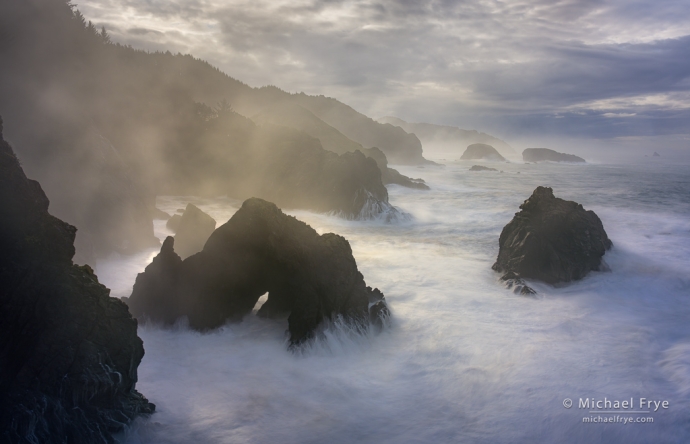
Sunlight breaking through clouds and fog, Oregon Coast. During our workshop we waited out a brief-but-heavy rain shower by sheltering underneath a dense tree canopy. After we emerged clouds blocked the sun for awhile, but eventually sunlight broke through and backlit the wave-generated mist for a few beautiful minutes. 28mm, 3 seconds at f/11, ISO 100, ND filter.
Sometimes I’m out with my camera on a clear, sunny day, and a passerby says, “What a beautiful day for photography!” I just smile and agree; there’s no point in discussing the finer points of landscape photography with a passing stranger.
And of course you can make good photographs on clear, sunny days. Those conditions are perfect for many subjects and scenes. But landscapes are usually more interesting and photogenic with clouds, fog, mist, snow, or rain – and the light that weather helps create, like sunbeams, rainbows, dappled light, colorful sunsets, and so on.
(more…)
by Michael Frye | Nov 24, 2024 | Light and Weather
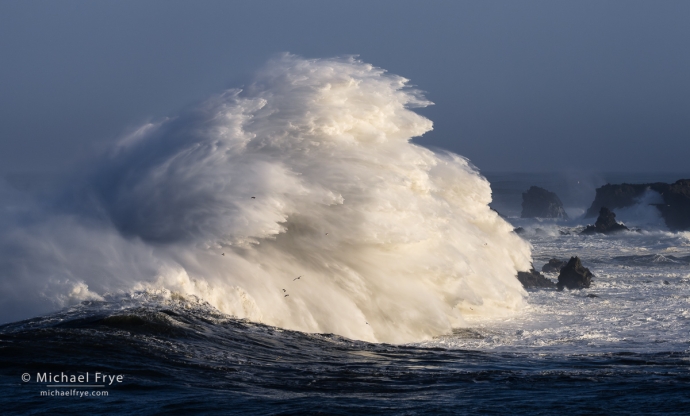
Breaking wave, Oregon Coast (from last Wednesday morning). This is one of the largest wave splashes I’ve ever seen. Note the gulls in front of the wave (you can click on this to see it larger). 192mm, 1/500 sec. at f/16, ISO 640.
After our Oregon Coast workshop Claudia and I hung around for a few more days, since we love this area, and the weather models were showing that more big waves were possible.
And I’m glad we stayed, as we did see some large waves last Monday, and then even bigger ones on Wednesday, after the “bomb cyclone” brought winds and heavy rain to the area on Tuesday and Tuesday night.
(more…)
by Michael Frye | Nov 17, 2024 | Light and Weather, Travels and Stories
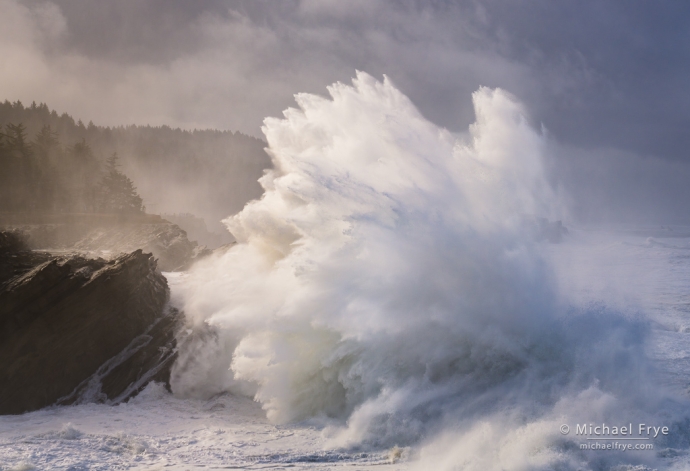
Crashing wave on a foggy morning, Oregon Coast
We just finished another edition of our Oregon Coast workshop, and once again had a great time. We had a really nice group of people, which always makes it more fun for everyone. And we encountered some wonderfully stormy weather.
The forecasts for the workshop showed a series of storms, and rain every day. But that didn’t mean nonstop rain. I knew there would be breaks, and those breaks could generate some interesting light.
(more…)
by Michael Frye | Nov 7, 2024 | Light and Weather, Travels and Stories
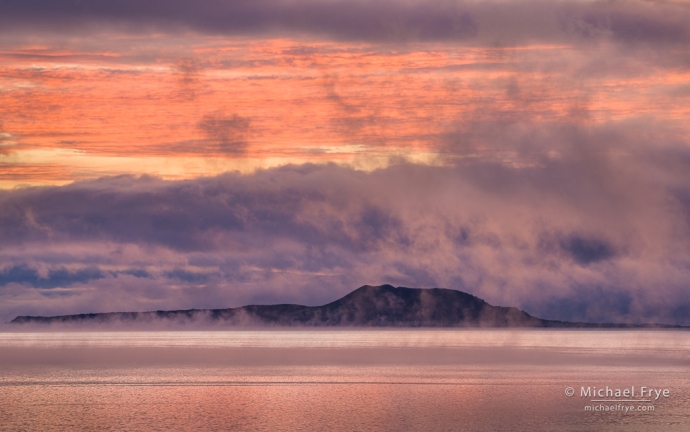
Fog and Negit Island, sunrise, Mono Lake, California
On our way home from Montana last month, Claudia and I stopped for the night in Lee Vining (near Mono Lake, just east of Yosemite). We met our friends Charlotte and Gary Gibb there, and had dinner with them at the Whoa Nellie Deli.
It was raining – the first significant weather we’d encountered on our whole trip. Then, just before sunset, the rain stopped, and we saw signs of clearing, so we rushed out to the shore of Mono Lake to catch the sunset. While we didn’t see the sun breaking through, we caught a nice sunset glow over the lake:
(more…)
by Michael Frye | Oct 13, 2024 | Composition, Light and Weather
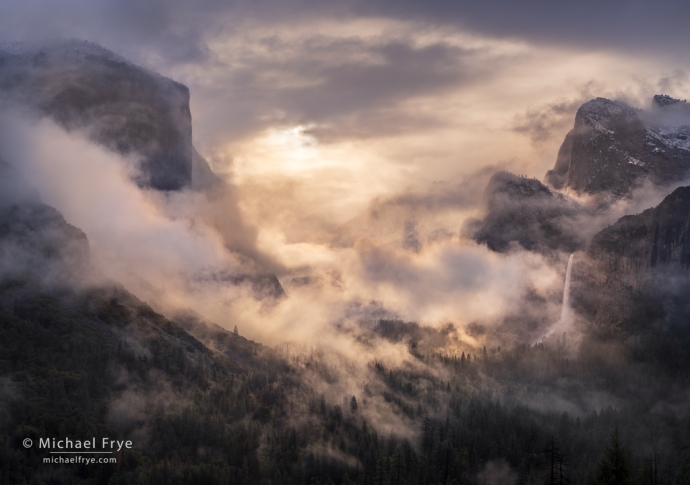
Misty sunrise from Tunnel View, Yosemite NP, California. Where does your eye go in this photograph? Here the brightest areas are in the middle of the image, while the edges are darker, helping to draw the eye into the picture, rather than out of the frame.
We launched our first online workshop about composition about 18 months ago, and then more recently added additional online workshops focused on light. I picked these topics because I think they are, hands down, the two most important aspects of photography.
In photography, nothing is more fundamental than light. When we press the shutter, we record the light falling on the film or sensor at that moment. Light is literally the medium we’re working with, and the quality of the light has everything to do with the mood and message of the photograph.
(more…)
by Michael Frye | Aug 11, 2024 | Light and Weather
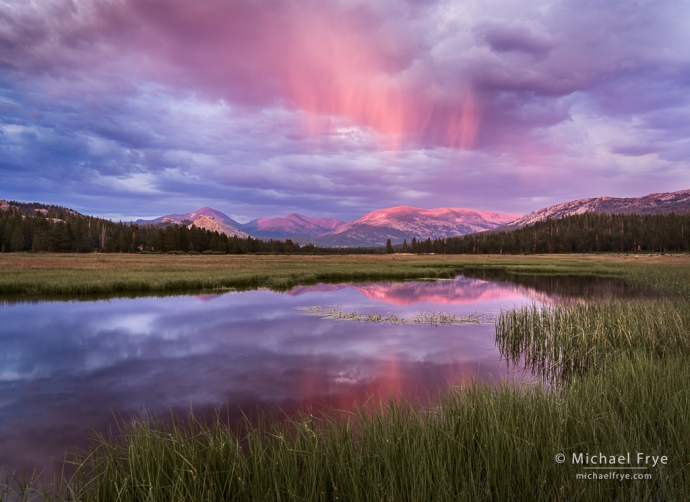
Sunset clouds, Tuolumne Meadows, Yosemite NP, California. Light from the setting sun caught some virga (rain that doesn’t reach the ground) falling from a passing thunderstorm.
I’ve been lucky to live in or near Yosemite for the last 40 years. It’s such a wonderful place. And for about five months of the year, when the Tioga Road is open, I can easily get up to the cool, uncrowded, beautiful high country. It’s always a treat to breathe the thin, pine-scented air while hiking to a secluded alpine lake, or a field of wildflowers.
Last year the Tioga Road didn’t open until July 22nd, its latest opening date ever, which limited the time we got to spend in the high country. But this year Claudia and I got to hang out up there for extended periods before, during, and after our Starry Skies and Range of Light workshops. While not at the record levels like 2023, we did have a good snowpack this year, keeping the water levels high in the creeks and rivers, and creating some nice wildflower displays. We also saw monsoonal moisture sometimes pushing up into the mountains, creating clouds, showers, and thunderstorms, which makes things exciting – and makes for interesting photographs. In other words, it was really beautiful.
(more…)














